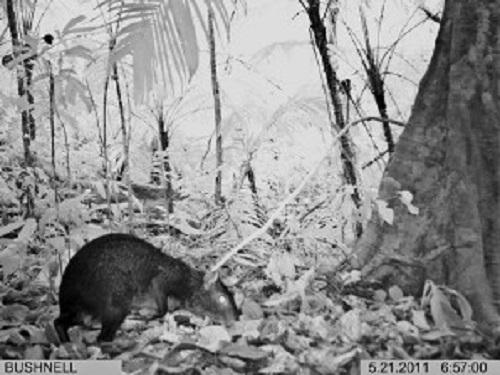Jenny Zambrano
I propose a long term project to test the effects of fragmentation of Poulsenia armata an animal-dispersed tree and access its population viability. This tree species has a particular strategy that makes it more susceptible to the fragmentation of the forest.

In the changing environment of a fragmented forest, it is necessary to determine the role of the remaining fauna in the regeneration of the forest in order to assess extinction risk of plants with which they interact. This requires an understanding of the population dynamics and the factors that drive changes in population size. While the “defaunation hypothesis” predicting major effects of loss of mammals on plant populations originated at Los Tuxtlas, virtually no relevant data document the phenomenon. Indeed, very few studies have documented how defaunation resulting from fragmentation affects plant regeneration at Los Tuxtlas, an area of great relevance as it represents the northern-most limit of tropical rainforest in the New World and highly diverse hotspot. The synergistic effects of hunting and fragmentation have severely reduced large and medium-sized mammal populations that are still present in the continuous forest, but are nearly extinct in the small fragments.

It is believed that small mammals could experience ecological release in the absence of their competitors, in Los Tuxtlas forests, but this hasn’t been documented. This could lead to a series of cascading effects on plant communities jeopardizing the survival of tree species with particular life strategies. This is the case of Poulsenia armata (Moraceae) an animal dispersed tree with a good seedling to juvenile recruitment but with a poor representation of saplings and canopy adults. Since more than 70% of tropical trees been dispersed by animals, it´s important to understand in which direction species with similar life strategies will move when conditions are changed. Therefore, I propose a long term study where the purpose is to test the effects of fragmentation in the life history of P. armata by comparing the conditions in the continuous and in the fragmented forests of Los Tuxtlas.
I will be testing the following hypothesis:
1) Fragmentation affects seed survival in P. armata,
2) Fragmentation affects seedling survival in P. armata,
3) Population growth rate of P. armata is being affected by the effects of fragmentation.
A unique aspect of this research is the possibility to simulate, with population matrix models, the population of P. armata over time in areas where major seed dispersers, seed predators and herbivores are depleted as a result of habitat lost. As the first study of its kind in this area, it will form the basis of conservation strategies to prevent the loss of tree species and their dispersal agents in tropical forests.